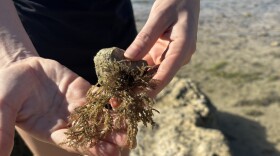Researchers are trying to better understand a certain mollusk's life cycle — by spawning it in a lab.
ʻOpihi over-harvesting is a major issue for the species, causing their population to plummet.
University of Hawaiʻi at Mānoa graduate students Angelica Valdez and Mitch Marabella have successfully spawned and raised ʻopihi in a lab, and are now working on taking their work outside.
However, their research of the endemic limpet has been difficult. They say that changing environmental conditions have made previous knowledge invalid.
Valdez says their research has helped better understand the species, but more research needs to be done.
"We know how to successfully raise them from sperm and egg to juvenile stages. And then once we hit that 30 Day stage, it's a mystery from that point," Valdez says.
"It's just getting them to react to the hormone we use or if we're just using environmental conditions like aeration and tidal changes recreated in the lab to get them to spawn. That's still quite a mystery."
Marabella and Valdez say they aim to find a method to spawn more ʻopihi in the lab to later be able to release in the wild.




